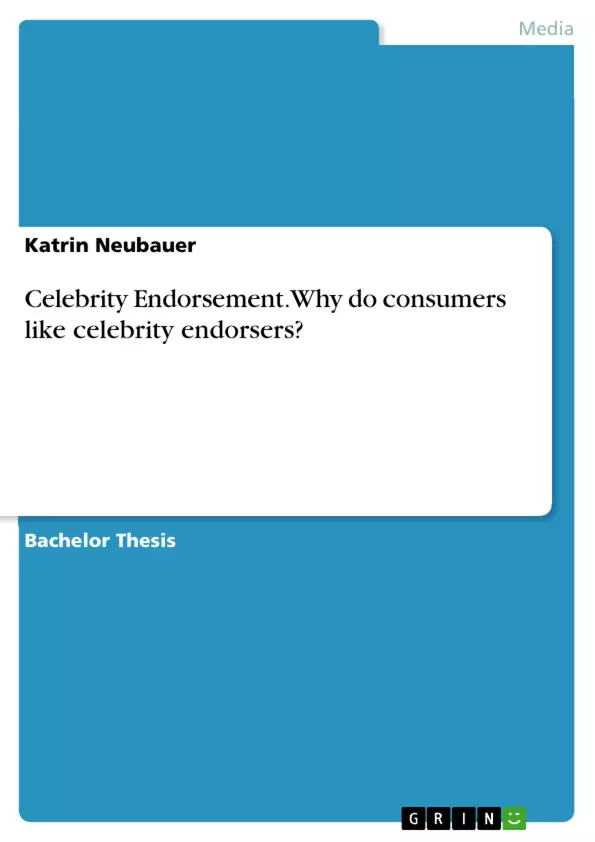The main aims of this study were to identify the primary reasons why consumers like celebrity endorsers, and whether or not the two genders express differences in their perceptions of celebrity endorsers.
The chosen celebrity was Heidi Klum. A large number of specialist literature sources suggested six outstanding likeability factors, namely: a celebrity’s luxury lifestyle, personal life, personality, attractiveness, successful career and credibility.
These likeability factors were investigated by means of 60 electronic questionnaires targeting Heidi Klum’s online social networking groups.
The results of this study largely conform with the previously published findings. Some minor variations in perceptions between men and women have been identified as part of the research investigation.
The study has revealed that all the above-mentioned factors are important in terms of liking a celebrity endorser.
Among them, “attractiveness” has been classed as the main reason why both women and men like a celebrity endorser.
Table of Contents
- 1 INTRODUCTION
- 1.1 Definition of Celebrity Endorser
- 1.2 Q-Score
- 1.3 Background of Celebrity Endorsement
- 1.4 Heidi Klum
- 1.4.1 Heidi Klum's Career
- 1.5 Outline
- 2 SOURCE LIKEABILITY
- 2.1 Luxury Lifestyle
- 2.2 Credibility
- 2.3 Personal Life
- 2.4 Personality
- 2.5 Attractiveness
- 2.6 Successful Career
- 3 CONSUMER BEHAVIOUR
- 3.1 Perception Process
- 3.2 Self-Concept
- 4 METHODOLOGY
- 4.1 Research Question and Objectives
- 4.2 Research Philosophy
- 4.3 Research Approach
- 4.4 Research Strategy
- 4.4.1 Time Horizon
- 4.4.2 Research Method
- 4.4.3 Data Collection Techniques
- 4.4.4 Questionnaire Design
- 4.4.5 Piloting
- 4.5 Sampling Definition
- 4.5.1 Sampling Techniques
- 4.5.2 Sampling Selection
- 4.6 Ethics, Non-Response and Response Bias
- 4.7 Research Limitations
- 5 ANALYSIS AND FINDINGS
- 5.1 Perception of HK's Luxury Lifestyle
- 5.2 Perception of HK's Personal Life
- 5.3 Perception of HK's Personality
- 5.4 Perception of HK's Attractiveness
- 5.5 Perception of HK's Successful Career
- 5.6 Perception of HK's Credibility
Objectives and Key Themes
This project aims to investigate why consumers favor celebrity endorsers. It utilizes a research methodology to explore consumer perceptions and preferences related to celebrity endorsements, focusing specifically on Heidi Klum as a case study.
- Consumer perception of celebrity endorsers
- The role of source likeability in celebrity endorsement effectiveness
- The influence of various celebrity attributes (luxury lifestyle, personal life, personality, attractiveness, successful career, credibility) on consumer preference
- Application of consumer behavior theories to understand endorsement choices
- Analysis of research methodologies in marketing research
Chapter Summaries
Chapter 1 introduces the concept of celebrity endorsement, defining key terms and providing background information. It also introduces Heidi Klum as the central case study and outlines the study's structure. Chapter 2 explores the concept of source likeability, examining its various dimensions including luxury lifestyle, credibility, personal life, personality, attractiveness, and successful career. Chapter 3 delves into relevant aspects of consumer behavior, focusing on the perception process and self-concept. Chapter 4 details the research methodology employed, covering the research question, philosophy, approach, strategy, sampling techniques, and data collection methods. Chapter 5 presents the analysis of findings concerning consumer perceptions of Heidi Klum across various attributes.
Keywords
Celebrity endorsement, consumer behavior, source likeability, Heidi Klum, perception, credibility, attractiveness, research methodology, marketing research.
- Quote paper
- BA Marketing Katrin Neubauer (Author), 2008, Celebrity Endorsement. Why do consumers like celebrity endorsers?, Munich, GRIN Verlag, https://www.grin.com/document/120481



